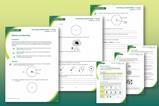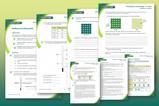Support your learners to develop mental models and deepen understanding of diffusion and chemical reactions
Developing understanding is a series of resources that encourage learners to connect their thinking at the macroscopic, sub-microscopic and symbolic levels.
-

Download this
A ramped worksheet to help learners develop and connect their mental models of diffusion and chemical reactions. With icons to indicate the conceptual level/s of each question.
View and download more Developing understanding worksheets
Learning objectives
- Connect understanding of diffusion and chemical reactions to explain the formation of a product from the reaction of two substances in the gas state.
- Connect understanding of diffusion and chemical reactions to explain the formation of a solid product when particles of two dissolving substances meet.
This resource aims to develop learners’ understanding of diffusion and chemical reactions. The questions encourage learners to think about the diffusion of reactants in the gas state and in solution and the formation of a product where they meet. As a result, learners should develop more secure mental models to support their thinking about this topic.
- When to use? Use after initial teaching or discussion of this topic to develop ideas further. You can also use as a revision activity.
- Group size? Suitable for independent work either in class or at home. Or use the questions for group or class discussions.
- How long? 15–30 mins
Johnstone’s triangle
Johnstone’s triangle is a model of the three different conceptual levels in chemistry: macroscopic, symbolic and sub-microscopic. You can use Johnstone’s triangle to build a secure understanding of chemical ideas for your learners.
Introduce learners to Johnstone’s triangle with our Diffusion of colour in water Johnstone’s triangle worksheet which guides learners to observe and describe the macroscopic diffusion of colour in water using symbolic and sub-micrscopic levels of thinking.
Further reading
Read more about how to use Johnstone’s triangle in your teaching with these articles:
- Develop deeper understanding with models
- Improve students’ understanding with Johnstone’s triangle
- Practical ideas for using Johnstone’s triangle
Norman Reid’s book The Johnstone Triangle: The Key to Understanding Chemistry provides an more in-depth overview, the first chapter is available to read online.
Johnstone’s triangle and this resource
The icons in the margin indicate which level of understanding each question is developing to help prompt learners in their thinking.
- Macroscopic: what we can see. Think about the properties that we can observe, measure and record.
- Sub-microscopic: smaller than we can see. Think about the particle or atomic level.
- Symbolic: representations. Think about how we represent chemical ideas including symbols and diagrams.
The levels are interrelated, for example, learners need visual representation of the sub-microscopic in order to develop mental models of the particle or atomic level. Our approach has been to apply icons to questions based on what the learners should be thinking about.
Questions may be marked with two or all three icons, indicating that learners will be thinking at more than one level. However, individual parts of the question may require learners to think about only one or two specific levels at a time.
Support
This worksheet is ramped so that the earlier questions are more accessible. The activity becomes more challenging in the later questions. You can give extra explanations for the more challenging questions. If completing as an in-class activity it is best to pause and check understanding at intervals, as often one question builds on the previous one.
It is useful for learners to observe macroscopic properties first-hand. You could circulate examples of substances in the classroom, run a class practical of a chemical reaction or show a teacher demonstration of properties.
Give learners physical models to use and manipulate, such as a Molymod™ kits or counters.
Additional support may be needed for any learners still lacking in confidence in the required symbolic representation, for example by sharing and explaining a diagram or a simulation that can show movement of the particles.
Answers and guidance
There are two multi-part questions in the student worksheet. The first question develops learners’ understanding of the diffusion of gases in terms of particles (sub-microscopic understanding) and the observation of this in terms of two diffusing gases meeting and reacting to form a visible white solid (macroscopic understanding). Watch an Exhibition chemistry video and download instructions to demonstrate this experiment.
The second and final question develops learners’ understanding of the formation of an observable solid product (precipitate) when soluble reactants meet through diffusion across a water droplet (macroscopic understanding). This question assumes some familiarity with dissolving and diffusion as well as experience of observing microscale reactions (download instructions and watch a video of this microscale neutralisation and precipitation reaction).
Downloads
Diffusion and chemical reactions Developing understanding student worksheet
Handout | PDF, Size 0.21 mbDiffusion and chemical reactions Developing understanding teacher notes and answers
Handout | PDF, Size 0.19 mbDiffusion and chemical reactions Developing understanding student worksheet
Editable handout | Word, Size 0.54 mbDiffusion and chemical reactions Developing understanding teacher notes and answers
Editable handout | Word, Size 0.53 mb






































No comments yet